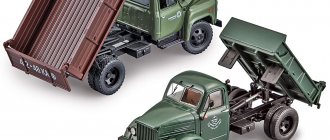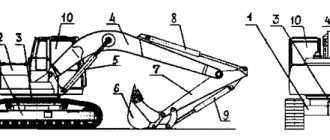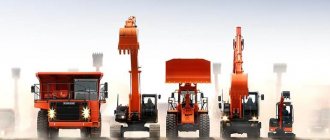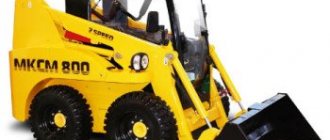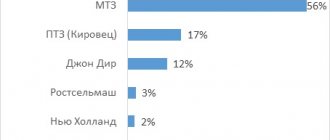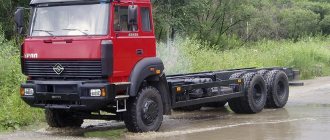Dump truck
- a self-unloading cargo vehicle, trailer or semi-trailer with a body (usually a bunker type), mechanically (usually hydraulically) tilted for unloading cargo or with forced unloading (for example, an auger).
There are also dump trucks, for unloading which the entire vehicle is tilted using telescopic lifts.
Dump trucks are used to transport bulk, bulk, or other cargo suitable for such unloading, which is carried out by tipping them out of the body.
Dump trucks are classified:
- By type of unloading (tilt or forced)
- In the direction of unloading (sideways, backwards)
- By body type (hopper, platform, sliding bunker, sliding platform)
Although the lifting capacity of a dump truck is less than that of a similar fixed-bed truck, dump trucks are still beneficial due to the reduction in unloading time. Dump trucks are distinguished by the method of unloading - rear, side, two-way and universal unloading on all sides. In Russia, dump trucks are produced by KAMAZ, URAL, GAZ, and Yarovit companies.
Road dump trucks[edit | edit code]
Dump trucks intended for public roads are produced by almost all truck manufacturers. These machines are used in construction, repair, public utilities, agriculture, and also in mining. They usually have from 2 to 4 axles and a load capacity of 40 tons. However, there are also more impressive equipment, for example, the European GINAF and Terberg, the Chinese Shacman produce 5-axle dump trucks, while American manufacturers (Freightliner, Kenworth, Western Star...) increase their number to 7. The design of these “centipedes” allows you to lift ( press) up to four axes and move while maintaining contact with the surface.
Body material
Modern dump truck bodies are usually welded and made from low-alloy steel designed to withstand high tensile loads. The world's leading manufacturers of mining dump trucks install bodies made of steel with a hardness of up to 400 HB (Brinnell), which ensures their high strength and abrasion resistance. The use of high-hardness steel makes it possible to abandon the currently common technology of protecting the bodies of heavy-duty dump trucks with armor sheets - the so-called lining. Wear-resistant and high-strength steel 110G13L, which has a surface hardness of up to 400...500 HB, is used today in Russia as a lining and reliably protects the body from impact and abrasive loads. However, this reduces the useful volume of the body and the weight of the payload. And replacing worn out lining sheets causes downtime of expensive equipment. A common disadvantage of steel bodies is their high dead weight and low corrosion resistance.
Dumping platforms are also made of aluminum alloys. Due to the lower dead weight of the body than that of a steel body, the weight of the transported cargo with the same load capacity of the dump truck chassis increases. Bodies made of aluminum alloys do not require careful painting because they do not corrode. Structurally, the body is assembled from sheets and hollow profiles of a special section. Moreover, sheets that are much thicker than the rest of the bottom sheets are placed on the bottom at the rear side, since maximum metal abrasion occurs in this area during unloading. To protect against the appearance of nicks and scuffs on the planes of the body that occur when loading large stones and debris as a result of their impacts on the sides, the body is covered with protective polymer materials.
Today, dump platforms made of reinforced plastics are successfully used. They have the same advantages over steel ones as bodies made of aluminum alloys.
Off-road (quarry) dump trucks[edit | edit code]
Quarry (off-road) dump trucks are used in open-pit mining. Due to their size and weight, operation on public roads is not possible. Large models are delivered to the job site in parts and assembled on site.
The most appropriate for heavy dump trucks is a design with two axles with rear or all-wheel drive and unloading of the body to the rear. In the 1970s, they tried to use three-axle dump trucks, such as the Terex Titan and WABCO 3200B, but such schemes did not take root in quarries. Kress offers bottom dump trucks, but this requires the use of a special unloading system.
Modern super-heavy dump trucks usually use a hybrid powertrain - a diesel engine drives an alternating current generator, which powers traction motors that rotate the wheels (see Electric transmission). The braking system is also a combined action of hydraulics and electric motors, which generate energy during braking mode. General Atomics (Terex), General Electric (Komatsu, BELAZ), Siemens (Hitachi, Liebherr, BELAZ) are working together to create an electric drive.
The Caterpillar 797B stands apart, as it does without unnecessary elements (generator and electric motors). This is facilitated by the world’s largest engine of those installed on trucks - CAT 3524B (two combined CAT 3512B), 24 cylinders, 117 liters in volume, torque exceeds 16,000 Nm (22% reserve). The car has a 7-speed hydromechanical transmission. Hydraulic brakes. However, the company is currently preparing for production of a new generation of dump trucks that will have a diesel-electric drive, developed jointly with Mitsubishi Electric.
The greatest efficiency of such giants is achieved when used in tandem with a hydraulic or cable excavator, which loads in 3-5 cycles. There are already excavators equipped with a bucket that can hold more than 76 cubic meters of rock (more than 100 tons), and on September 26, 2013, the BelAZ-75710 dump truck was presented at the test site of the Belarusian Automobile Plant, which allows transporting 450 tons of payload.[1]
Currently, more than 20 companies are producing mining dump trucks. The main part of the market, more than 95%, is made up of dump trucks with a lifting capacity of up to 40 tons.
In Russia, mining dump trucks are being developed, releasing a 60-ton version in 2018. [ source not specified 292 days
]
The most lifting models from leading manufacturers:
| Manufacturer | Model | Load capacity, tons | Gross weight, tons | Engine | Power, l. With. | Maximum speed, km/h | Year of issue | Link |
| BELAZ | 75710 | 450 | 810 | MTU / Siemens MMT 500 | 4600 | 64 | 2013 | [2][3][4] (inaccessible link) |
| Caterpillar | 797F | 363 | 623 | Caterpillar | 4000 | 67 | 2009 | [5] |
| Unit Rig (Terex) | MT 6300AC | 363 | 598 | MTU | 3750 | 64 | 2008 | [6] |
| Liebherr | T 282 °C | 363 | 592 | MTU | 3755/4023 | 64 | 2010 | [7] |
| Liebherr | T 282 B | 363 | 592 | MTU | 3650 | 64 | 2004 | [8] |
| Komatsu | 980E | 363 | 625 | Komatsu | 3500 | 61 | 2016 | [9] |
| BELAZ | 75601 | 360 | 610 | MTU | 2800/3807 | 64 | 2010 | [10] |
| Caterpillar | 797B | 345 | 623 | Caterpillar | 3550 | 67 | 1998 | [11] |
| Komatsu | 960E | 327 | 576 | Komatsu | 3500 | 65 | 2008 | [12] |
| Unit Rig (Terex) | MT 5500 | 326 | 543 | MTU/Cummins | 2700 | 64 | 2006 | [13] |
| BELAZ | 75600 | 320 | 560 | Cummins | 2610/3549 | 64 | 2006 | [14] |
| Terex | 33-19 Titan | 317,5 | 550 | Electro-Motive | 3300 | 48 | 1974 | |
| Caterpillar | 795F AC | 313 | 570 | Caterpillar | 3400 | 64 | 2009 | |
| Euclid-Hitachi | EH 5000 | 286-315 | 528 | MTU | 2700 | 67 | ? | [15] |
| Liebherr | TI 274 | 290 | ? | MTU | 3000 | 64 | 2007 | [16] |
| Komatsu | 930E | 290 | 502 | Komatsu | 2700/3500 | 64 | 1996 | [17] |
| Euclid-Hitachi | EH 4500 | 282 | 435 | MTU/Cummins | 2700 | 67 | ? | [18] |
| Komatsu | 860E | 254 | ? | Komatsu | 2700 | 64 | 2008 | |
| BELAZ | 75310 | 240 | 401 | Cummins | 1864/2535 | 64 | ? | [19] |
| Euclid | R260 | 238 | 387 | Detroit Diesel | 2500 | 49 | 1997 | |
| Caterpillar | 793F | 226,8 | 390 | Caterpillar | 2650 | 60 | 2009 | |
| Komatsu | 830E | 222 | 385 | Komatsu | 2500 | 49 | ? | [20] |
| BELAZ | 75307 | 220 | 376 | Cummins | 1715/2330 | 64 | ? | [21] |
| BELAZ | 75306 | 220 | 376 | Cummins | 1715/2330 | 43 | ? | [22] |
| BELAZ | 75302 | 220 | 376 | MTU | 1715/2330 | 43 | ? | [23] |
| Kress | 200C | 220 | 342 | Caterpillar | 1700 | 73 | ? | [24] |
| Unit Rig (Terex) | MT 4400AC | 218 | 392 | MTU/Cummins | 2700 | 64 | ? | [25] |
| Liebherr | T 262 | 218 | 390 | MTU | 2500 | 51 | ? | [26] (unavailable link) |
| Caterpillar | 793B | 218 | 383 | Caterpillar | 2415 | 54 | ? | |
| WABCO | 3200V | 214 | 383 | G.M. | 2475 | ? | 1978 |
Body shape
The bodies of mining dump trucks must be equipped with a protective visor covering the cab roof. Such protection against falling objects is one of the requirements of the international FOBS standard, which regulates the safety of the driver’s workplace. The design of mining dump trucks, as a rule, uses a tipping body with rear unloading. And in general, this type of body is most widespread in dump trucks.
Of great importance when installing a body of a particular cross-section are the nature of the cargo being transported, the required location of the center of gravity, the required structural rigidity, as well as the possibility of unloading material with minimal losses. Dump trucks using rectangular bodies are the most stable compared to vehicles equipped with other types of bodies. The center of gravity with this body design is as low as possible. The capacity of a body with a rectangular cross-section is higher than the volume of a body with a semi-elliptical or trough-shaped cross-section (i.e., with beveled sides).
The tailgate is most often made lockable, which ensures transportation of high-density cargo without loss. It can open and close automatically using a valve, like on a MAZ-503B dump truck. But, as a rule, a redundant manual opening and closing mechanism is provided.
A negative factor when using bodies with a rectangular cross-section is that with this body shape it is difficult to achieve complete unloading; in winter, the cargo sticks to the internal surfaces, especially in the corners. To combat freezing of transported soils and mortars, the bodies are heated. Special channels are installed under the bottom and on the sides through which exhaust gases pass. There is another design, which consists in installing a special tray under the body, on the frame, connected to the exhaust system. Exhaust gases passing through this device heat it and the adjacent bottom of the body. The option of welding the second bottom is also used. In this case, exhaust gases pass between the welded and “base” bottom of the body and heat it up. But the last two solutions provide heating, although quite high, but only the bottom, while the first option, although more complex in execution, solves the problem more completely.
For more complete unloading, the lower corners of the side boards are beveled or rounded to a large radius. The most “high-quality” unloading is inherent in bodies with an oval cross-section, but bodies of this cross-section are inferior in rigidity to bodies whose internal surface is made in the form of a rectangular box or even a polyhedron.
The longitudinal section of the bodies is often rectangular: this shape provides maximum usable volume. The front side may have a slight slope towards the cabin. As a rule, this is due to the layout of the machine components, the location of the body lifting mechanism, etc.
Bucket-type bodies do not have a tailgate; its role is played by a slightly raised rear part of the body. Bucket bodies are widely used when transporting mortars, concrete mixtures, and bulk materials. This design greatly facilitates the driver’s work, since there is no need to open and lock the side when unloading. An all-welded body is much more airtight than platforms with opening side sides, and this is another positive property of bucket bodies. But a huge disadvantage is that for optimal unloading it is necessary to lift the body to an angle of up to 80°, and when the body is raised to such an angle, if it also contains concrete or wet sand, the lateral stability of the dump truck is seriously reduced. For comparison: for complete unloading, platforms with opening sides require a lifting angle of no more than 60°.
Articulated dump trucks[edit | edit code]
Main article: Articulated dump truck
An articulated dump truck (dump truck, articulated dump truck, articulated hauler, articulated dump truck, dumper) is used in construction and quarry work, where increased cross-country ability and maneuverability are required. Three-axle models of articulated dump trucks have six drive wheels. Moreover, modern dump truck models are equipped with a cross-axle differential switch.
Caterpillar
uses the “Ejector” system on its dump trucks (models 730 Ejector and 740 Ejector) - a movable wall in the body pushes out its contents, which allows unloading on the move, without tipping the body.
Bell
can offer dump trucks with crawler tracks.
Hydrema
It has a rotating body mechanism, this makes it possible to unload not only backwards, but also to any of the sides.
Articulated dump trucks are produced by the following companies: Astra, Bell Equipment (known in Asia and Australia under the Hitachi brand, and in America under the DEERE (John Deere) brand), Case, Caterpillar, Hydrema, JCB, Komatsu, Liebherr, Moxy, Terex, Volvo , BELAZ, MoAZ, BALTIETS (“ZSM-BALTIETS”)
The most load-bearing models:
| Manufacturer | Model | Load capacity, tons | Gross weight, tons | Engine - Power HP. s./Torque Nm. | Maximum speed, km/h | Link |
| Moxy | MT51 | 46,2 | 77,6 | Cummins - 510hp / - | 54 | [27] |
| Bell | B50D | 45,4 | 79,9 | Mercedes - 523hp / 2147Nm | 48 | [28] |
| Hitachi | AH500-D | 45,4 | 81,5 | Mercedes - 523hp / 2147Nm | 48 | [29] |
| Caterpillar | 740 | 39,5 | 72,6 | Caterpillar - 469hp / 2412Nm | 54 | [30] |
| Volvo | A60H | 55 | 98,4 | Volvo - 673hp / 3200Nm | 55 | [2][31] |
| Caterpillar | 740 Ejector | 38 | 73,6 | Caterpillar - 469hp / 2412Nm | 54 | [32] |
| Terex | TA40 | 38 | 68,8 | Detroit Diesel - 450hp / 2100Nm | 60 | [33] |
| Moxy | MT41 | 37,2 | 64,3 | Scania — 450hp / — | 53 | [34] |
| Bell | B40D | 37 | 66,8 | Mercedes - 422hp / 1974Nm | 52 | [35] |
| Hitachi | AH40-D | 37 | 66,9 | Mercedes - 422hp / 1974Nm | 52 | [36] |
| John Deere | 400D | 37 | 66,9 | Mercedes - 422hp / 1974Nm | 52 | [37] |
| Astra | ADT 40C | 37 | 66 | Iveco - 455hp / 2000Nm | 50 | [38] |
| Komatsu | HM400-2 | 36,5 | 69 | Komatsu - 453hp / 2090Nm | 58 | [39] |
| Case | 340B | 36 | 65 | Case - 456hp / 2000Nm | 50 | [40] |
Classification
Since its introduction in 1931, the mining dump truck has not undergone significant changes. Most models are identical to each other. However, the equipment still has a number of differences, which determine the ability of a particular truck to operate in certain conditions. Dump trucks are classified according to the following parameters:
- unloading method – tilting or forced;
- direction of cargo unloading - backwards or to the sides;
- body type - open or bunker.
Dump trucks for underground work[edit | edit code]
Main article: Underground dump truck
Dump trucks for underground work are designed for transporting and unloading blasted or mechanically loosened rocks in cramped conditions in underground mines, during mining and tunnel construction. The design allows them to be used in open-pit mines, but not as effectively.
Underground dump trucks are produced by Atlas Copco, Caterpillar, DUX Machinery, Paus, Sandvik, BELAZ, MoAZ
The most load-bearing models:
| Manufacturer | Model | Load capacity, tons | Own weight, tons | Engine - Power HP. With. | Wheel formula | Maximum speed, km/h | Link |
| Sandvik | Supra 0012H | 80 | 58 | Detroit Diesel - 425hp | 10×8 | — | [41] |
| Caterpillar | AD60 | 60 | 50 | Caterpillar - 805hp | 4×4 | 41 | |
| Sandvik | TORO 60 | 60 | 48,5 | Cummins - 760hp | 6×4 | — | [42] |
| Atlas Copco | MT6020 | 60 | 43,9 | Cummins - 760hp | 4×4 | — | [43] |
| Caterpillar | AD55B | 55 | 47 | Caterpillar - 805hp | 4×4 | 41 | |
| Sandvik | TORO 50 | 50 | 32,5 | Detroit Diesel - 525hp | 4×4 | — | [44] |
| Atlas Copco | MT5020 | 50 | 42 | Cummins - 650hp | 4×4 | — | [45] |
| Caterpillar | AD45B | 45 | 40 | Caterpillar - 587hp | 4×4 | 52 | |
| DUX | TD45 | 41 | 39,4 | Detroit Diesel - 575hp | 4×4 | — | [46] |
| Sandvik | TORO 40 | 40 | 30,7 | Detroit Diesel - 475hp | 4×4 | — | [47] |
| BELAZ | 75800 | 40 | 35,5 | Cummins - 476hp | 4×4 | 40 | [48] |
| MoAZ | 7508 | 35 | 29 | YaMZ - 360hp | 6×4 | 40 |
Dump trucks for snow removal are specialized equipment designed for transporting snow to snow melting points.
Features and Benefits
Mining dump trucks are enormous in size and weight. For this reason, they cannot travel on public roads. The equipment is delivered to the site of operation in parts, after which it is assembled directly in the quarry or on the territory of the enterprise. The main advantages of dump trucks of this type are:
- ability to transport up to 500 tons of cargo at a time,
- moving at a speed of 60 km/h, taking into account its impressive dimensions,
- the ability to pass through hard-to-reach places.

